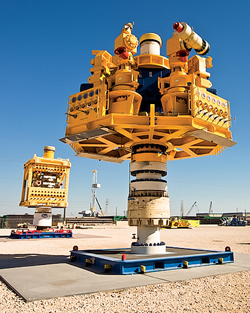Offshore in depth
|
As domestic and international majors continue to invest in E&P activities in the Gulf of Mexico (GOM), where water depths and wells are getting deeper, the need to be well-prepared for a containment incident is becoming increasingly important. According to Barclays, by the end of 2013, E&P spending is expected to have hit a record high of more than $670 billion, with a healthy chunk going to GOM operations. Companies are slowly ramping up activity in the region post-Macondo, and the Bureau of Safety and Environmental Enforcement (BSEE) virtually ensures that operators protect their enormous investments by regulating offshore safety systems and spill response planning.
In June of this year, BSEE’s Safety and Environmental Management Systems (SEMS) II rule took effect, expanding, revising and adding to the list of safety regulations by which GOM operators are required to abide. SEMS II provides tools that aim to help companies mitigate, or potentially avoid, offshore safety issues that may result from factors like human error or equipment failure. Guidelines for appropriate stop-work authority, employee participation and job safety analysis are included in the new rule, along with key regulations that enable offshore personnel to report unsafe working conditions directly to BSEE, and to require independent, accredited audit team leads. Following a roughly six-month compliance window, only 12 of the 84 companies subjected to a Nov. 15 SEMS II deadline failed to submit audit plans in adherence with the new regulations. Firms that did not comply in time were given a three-day period in which to reach a safe stopping point in operations, starting Nov. 16. BSEE said it determined that the impact of these stop-work orders on GOM production would be “miniscule.” The agency reported that, “while most of the companies [cited] are conducting plugging and abandonment, or other decommissioning activities, the elements of a SEMS program are applicable to all offshore operations.” This latest announcement from the regulator means that many of the region’s bases are covered, but not all of them. On the other side of the equation, and often working closely with BSEE, is Marine Well Containment Company (MWCC). Initially formed by four companies following the 2010 spill, the group’s membership now comprises Anadarko, Apache, BHP Billiton, BP, Chevron, ConocoPhillips, Exxon Mobil, Hess, Shell and Statoil. After making available an interim containment system (ICS) in February 2011, MWCC and its members are in the process of implementing an expanded containment system (ECS) by late 2014. Much like the ongoing efforts to update and augment SEMS regulations, the company’s expansions to its current system, and plans for the future, are meant to keep pace with the changing landscape of E&P activity, specifically in the Gulf. MWCC most recently upgraded the single-ram capping stack in its ICS to be able to cap wells with fluids up to 350°F, at pressures up to 15,000 psi; conditions that are increasingly common, as group members explore newer, more challenging plays. “Increasing the rating to 350°F required upgrading multiple pieces of equipment, including a lower spacer spool, ATV valves, upper H4 mandrel and SCC blind flange, to ensure higher temperatures could be tolerated,” said MWCC CEO Marty Massey. The group, he said, “received technical input from its member companies and industry providers throughout the rerate process, and also worked closely with regulators to ensure all requirements were met.” MWCC plans to bring additional well containment capabilities to the GOM through the roll-out of its ECS, which will considerably reduce the amount of vessel traffic required in a response situation, allowing for the capping of wells beneath floating structures, such as TLPs and spars. The group’s CTO, Charlie Miller, explained that the new system’s most significant updates include an increased flowback depth, from 8,000 ft to 10,000 ft, as well as expanded flowback capacity. If a well cannot be capped, fluids can be flowed back to two modular capture vessels (MCVs)—converted Aframax tankers—at a rate of 100,000 bpd, up from 60,000 bpd in the current set-up. Through yearly workshops with its member companies, Miller said MWCC is able to glean information about things like planned drilling designs and well conditions, to anticipate potential well containment needs. Because MWCC members in the Gulf must be able to demonstrate access to proper containment capabilities prior to receiving the necessary drilling permits, a constantly-evolving subsea containment system is of unprecedented importance. Clarification: Further clarifying Pacific Drilling’s fleet, mentioned in this column last month, the firm already operates four drillships. The Pacific Khamsin will be the fifth rig to join the firm’s fleet, and its third in Nigeria. |
- Advancing offshore decarbonization through electrification of FPSOs (March 2024)
- Subsea technology- Corrosion monitoring: From failure to success (February 2024)
- Driving MPD adoption with performance-enhancing technologies (January 2024)
- Digital transformation: A breakthrough year for digitalization in the offshore sector (January 2024)
- Offshore technology: Platform design: Is the next generation of offshore platforms changing offshore energy? (December 2023)
- 2024: A policy crossroads for American offshore energy (December 2023)
- Applying ultra-deep LWD resistivity technology successfully in a SAGD operation (May 2019)
- Adoption of wireless intelligent completions advances (May 2019)
- Majors double down as takeaway crunch eases (April 2019)
- What’s new in well logging and formation evaluation (April 2019)
- Qualification of a 20,000-psi subsea BOP: A collaborative approach (February 2019)
- ConocoPhillips’ Greg Leveille sees rapid trajectory of technical advancement continuing (February 2019)



